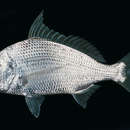Diagnostic Description
(
anglais
)
fourni par Fishbase
Live specimens' head and trunk sides olive-green above, becoming silvery below; snout region blackish dorsally; dorsal fin membrane with faint black blotches or small spots at each spine and ray, just above edge of scaly basal sheath, silvery anteriorly on 1st-5th dorsal spine, grading to hyaline on spinous and soft dorsal fin; anal fin scaly basal sheath silver; distal part of pelvic fin between 1st-5th soft rays often white or hyaline for 1/5-1/3 of ray length, other parts hyaline or slightly yellowish; pectoral and anal fins hyaline. Caudal fin dusky with broad darker margin posteriorly which may be indistinct in old or poorly preserved specimens; ventral edge of lower caudal fin lobe white or bluish-white. Generally, body with prominent dark stripes along scale rows above lateral line (distinct in preserved specimens); 4-9 somewhat oblique dusky bars or columns of ovoid dark spots immediately below lateral line in specimens over 10 cm SL (dusky bars on less than 10 cm) but more apparent in preserved or stressed individuals. Scales between 5th dorsal fin spine base and lateral line 5-6.5 (modally 5.5). Upper jaw extending vertically beyond anteriormost margin of dermal eye opening, sometimes reaching to vertical at anterior margin of pupil. Second dorsal fin spine longest, 17-25% SL (Ref. 41108, 4372). Pre-opercle lower flange scaled. Body depth max 2.3-2.8 in SL. Pectoral fins reaches to or beyond level of anal-fin origin; caudal fin forked deeply (Ref. 90102). Pelvic fin of Red Sea specimens solid yellow with a narrow white distal margin; anal fin with a yellow tinge between the first rays; pectoral fin base with a dark brown spot (Horst Moosleitner, personal communication, homosub@aon.at). Examination of the meristic and morphometric data of the syntypes of G. lineolatus and G. rueppellii, and holotype of G. darnleyense showed all these are subadult or young specimens of G. longirostris (Ref. 41108).
- licence
- cc-by-nc
- droit d’auteur
- FishBase
- Recorder
- Cristina V. Garilao
Migration
(
anglais
)
fourni par Fishbase
Amphidromous. Refers to fishes that regularly migrate between freshwater and the sea (in both directions), but not for the purpose of breeding, as in anadromous and catadromous species. Sub-division of diadromous. Migrations should be cyclical and predictable and cover more than 100 km.Characteristic elements in amphidromy are: reproduction in fresh water, passage to sea by newly hatched larvae, a period of feeding and growing at sea usually a few months long, return to fresh water of well-grown juveniles, a further period of feeding and growing in fresh water, followed by reproduction there (Ref. 82692).
- licence
- cc-by-nc
- droit d’auteur
- FishBase
Morphology
(
anglais
)
fourni par Fishbase
Dorsal spines (total): 9; Dorsal soft rays (total): 10; Analspines: 3; Analsoft rays: 7
- licence
- cc-by-nc
- droit d’auteur
- FishBase
- Recorder
- Cristina V. Garilao
Trophic Strategy
(
anglais
)
fourni par Fishbase
Prefers brackish waters, often found in estuaries and coastal lagoons. Forms schools. Feeds on small bottom invertebrates (Ref. 3409).
- licence
- cc-by-nc
- droit d’auteur
- FishBase
Biology
(
anglais
)
fourni par Fishbase
Adults often in clear coastal waters up to about 50 m depth; juveniles often in estuaries or lagoons influenced by fresh water (Ref. 41108); they prefer shallow waters over sandy bottoms, from coral reefs to brackish waters (Ref. 30573). Fry about 10 cm in length enter the estuaries and stay until they reach maturity (Ref. 34363). Occur singly or in groups (Ref. 9710). Feed on small bottom invertebrates (Ref. 3409). In the Gilberts, the species forms spawning aggregations for a few days around the new moon (Ref. 37816). Sold fresh in markets; processed into fishmeal. Also taken with stake-nets (Ref. 3409).
- licence
- cc-by-nc
- droit d’auteur
- FishBase
Importance
(
anglais
)
fourni par Fishbase
fisheries: commercial
- licence
- cc-by-nc
- droit d’auteur
- FishBase

